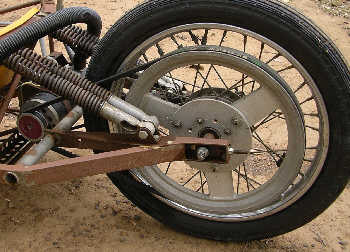Transmission is by single V-belt ( 'A" section)
A small pulley on the motor transmits power to a large 360mm pulley on the wheel.
The motor is mounted on the chassis, its centreline passes through the swingarm pivots so that the belt's tension does not vary with up and down wheel movements.
The drive ratio is easily changed for different conditions.
A small set of motor pulleys provides for the complete terrain range
from smooth level bitumen to undulating paddock bashing.
As an electric motor's torque is highest at standstill
neither gearbox nor clutch is required.
